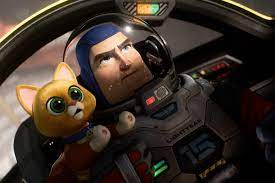To Capitalism and Beyond! (Movie Review: Lightyear)
 Is Pixar the greatest animation studio in the history of film? Possibly. It can certainly compete with Disney, its quasi-parent, along with the mighty Studio Ghibli of Japan. For my Money, Pixar slightly edges out Studio Ghibli and comes out on top due to two factors — the quality of animation and innovative storytelling. From 1995 to 2010, nearly every Pixar release could be considered a classic. I’ll grant you that Monsters, Inc. is well-meaning fluff, and I recognize that Cars is less geared toward families and more aimed at young children. But Wall-E, Up, The Incredibles, and Ratatouille are all kind of masterpieces.
Is Pixar the greatest animation studio in the history of film? Possibly. It can certainly compete with Disney, its quasi-parent, along with the mighty Studio Ghibli of Japan. For my Money, Pixar slightly edges out Studio Ghibli and comes out on top due to two factors — the quality of animation and innovative storytelling. From 1995 to 2010, nearly every Pixar release could be considered a classic. I’ll grant you that Monsters, Inc. is well-meaning fluff, and I recognize that Cars is less geared toward families and more aimed at young children. But Wall-E, Up, The Incredibles, and Ratatouille are all kind of masterpieces.
Toy Story is the big one, though. It’s the one that shot Pixar into the stratosphere and proved computer animation could work, the ur-text for every story they would proceed to tell. While Disney adapted fairy tales and folklore, Pixar created concepts that were brilliant, and they began with a deceptively brilliant idea. What if toys came to life? That concept spawned a host of beloved characters, a critically acclaimed (and highly profitable!) trilogy, as well as a somewhat unnecessary yet charming fourth film.
Things change, though. Right now, popular film exists in a weird space. Instead of building toward the Infinity Gauntlet, the MCU appears to be building toward time Travel, a multiversal conflict, and a deep-cover team of reprobates — all at the same time. Star Wars is focusing on television and focusing on its past. What about Pixar? Well, that’s where it gets tricky.
On the one hand, they’re still releasing interesting features such as Soul and Turning Red.* Yet 2021’s Luca, while profitable and well-reviewed, doesn’t seem to have made much of a dent in the popular Consciousness. Pixar hasn’t made a splash in a minute. They seem to think they need one. Why else would Lightyear exist? Don’t get me wrong, I liked it, but I struggle to understand why it exists in the first place.
 “In 1995, a boy named Andy got a Buzz Lightyear toy for his birthday. It was from his favorite movie. This is that movie.” Right out of the gate, the title card tells us what we’re going to watch. It also subtly informs us of what we’re not going to see. There will be no Woody cameos, no Mr. Potato Head hijinks, and no Randy Newman tunes.
“In 1995, a boy named Andy got a Buzz Lightyear toy for his birthday. It was from his favorite movie. This is that movie.” Right out of the gate, the title card tells us what we’re going to watch. It also subtly informs us of what we’re not going to see. There will be no Woody cameos, no Mr. Potato Head hijinks, and no Randy Newman tunes.
Instead, we meet the “real” Buzz Lightyear (Chris Evans), an ultra-competent and somewhat pigheaded Space Ranger in the employ of Star Command. He’s exploring the cosmos, seeking out new life and new civilizations, boldly going…well, you know. Buzz, along with his commander Alisha Hawthorne (Uzo Aduba) discovers a new planet. On the one hand, they’re shepherding a large group of colonists and need to be mindful of their welfare. On the other, the planet might be a safe place to colonize.
As it turns out, it isn’t. The lifeforms they encounter are definitely hostile, and the Space Rangers beat a hasty retreat. Unfortunately, Buzz’s ego gets the best of him and their craft is damaged. So much so that it’s grounded for a year. Buzz blames himself. Alisha knows her partner meant well and encourages him to make the best of things. Yet he just can’t shake his failure and becomes obsessed with testing an energy source that will allow them to jump to hyperspace and bug out of there.
Easier said than done, considering that each time Buzz tests the hyperdrive unsuccessfully, he jumps forward in time four years. He misses Hawthorne falling in love, misses the birth of her child, and after finally achieving his goal and leaping twenty-two years into the future, Buzz misses her death. It’s depressing, so much so that Buzz’s robotic emotional support cat Sox (Peter Sohn) can’t shake the Space Ranger out of his galaxy-sized funk.
Buzz gets the message from Izzy (Keke Palmer), Alisha’s adult daughter. He’s returned at a relatively good time as the planet needs a hero. It’s been overrun by mysterious robots, and the current commander Burnside (Isaiah Whitlock Jr.) believes Buzz is a liability. Izzy thinks otherwise, and she drafts Buzz to join elderly ex-con Darby Steel (Dale Soules) and perpetual screwup Mo Morrison (Taika Waititi) to solve the cybernetic mystery and save the day. Like you do.

So…look. This is a “my problem and not the film’s problem” kind of thing and we’ll get to my problem soon. First, it’s important you understand that director Angus MacLane has made a colorful, fast, and fun sci-fi adventure. There are narrow escapes, clever action sequences, and all manner of derring-do. With a $200 million budget and the might of Disney behind him, MacLane oversees state-of-the-art animation that looks terrific. His pacing is quick when it needs to be, and he knows when to slow down a little to let us get to know the characters.
Speaking of character, writers MacLane and Jason Headley acquit themselves nicely in living up to Pixar’s usually high storytelling standards. While all the main characters are broadly drawn, they all have something approximating an arc. The gags are as solid as you’d expect, and there are a few sequences of genuine emotional power.
The voice acting is solid, which is not exactly shocking news. If you want Buzz to sound like a twenty percent more egotistical version of Captain America, you get Chris Evans. He’s a solid performer who ably handles both the drama and comedy of the toyetic Space Ranger. I enjoyed Keke Palmer’s Izzy, who balances her joy for adventure with an almost crippling fear of space, and I quite liked Dale Soule’s Darby, who is super, super into blowing things up. The film is stolen by Peter Sohn’s Sox, an empathetic robot that’s only occasionally seized by his feline instincts.
 Based on the previous three paragraphs, you’d think that I’m thinking Lightyear is just jim-dandy. Here’s where my problem enters the equation. While I’m good with a somewhat goofy sci-fi adventure, did this one absolutely have to be about Buzz Lightyear? That character is beloved due to Tim Allen’s excellent vocal performance, a strongly conceived character, and how he bounces off the other characters in Toy Story. That’s why we love Buzz, but none of that has anything to do with the framework created by Lightyear. The whole idea of making the movie that’s based on the toy is highly meta, and then despite some throwaway moments of catchphrases and character beats we’ve seen in the past, it stops being meta.
Based on the previous three paragraphs, you’d think that I’m thinking Lightyear is just jim-dandy. Here’s where my problem enters the equation. While I’m good with a somewhat goofy sci-fi adventure, did this one absolutely have to be about Buzz Lightyear? That character is beloved due to Tim Allen’s excellent vocal performance, a strongly conceived character, and how he bounces off the other characters in Toy Story. That’s why we love Buzz, but none of that has anything to do with the framework created by Lightyear. The whole idea of making the movie that’s based on the toy is highly meta, and then despite some throwaway moments of catchphrases and character beats we’ve seen in the past, it stops being meta.
Lightyear is Angus MacLane’s baby. He loves the character, loves his world, pitched the concept, and oversaw its development from start to finish. MacLane made a good film. I’m hoping he makes more. He made a film that I can’t connect with or get comfortable with and I suspect nobody really cares about that. Nor should they! If you don’t have my issues, I’d bet the weekend gross you’ll like it. In the meantime, my hangups and I will be going to infinity and beyond.
*Consider that two Pixar features were released in 2022, Turning Red and Lightyear. One is about a Chinese-Canadian girl turning into a red panda, which is a metaphor for puberty. The other is about a white guy going on a sci-fi adventure. Guess which one got a wide theatrical release and which one was unceremoniously dumped onto Disney+?
The post To Capitalism and Beyond! (Movie Review: Lightyear) first appeared on OnJournalists.























